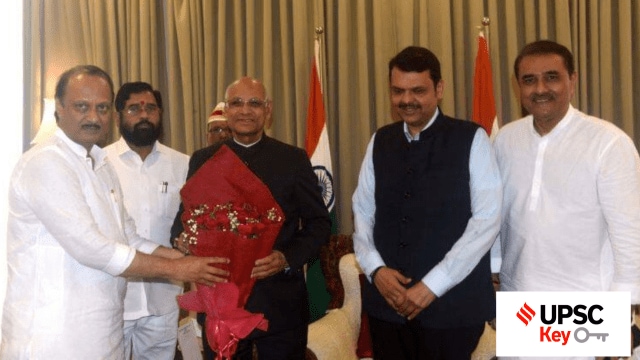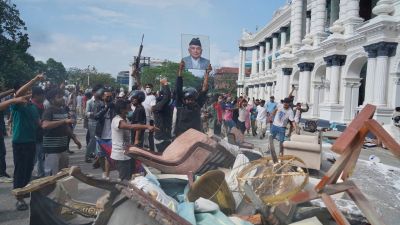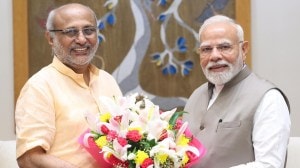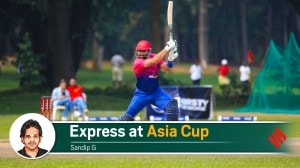Priya Kumari Shukla is a Senior Copy Editor in the Indian Express (digital). She contributes to the UPSC Section of Indian Express (digital) and started niche initiatives such as UPSC Key, UPSC Ethics Simplified, and The 360° UPSC Debate. The UPSC Key aims to assist students and aspirants in their preparation for the Civil Services and other competitive examinations. It provides valuable guidance on effective strategies for reading and comprehending newspaper content. The 360° UPSC Debate tackles a topic from all perspectives after sorting through various publications. The chosen framework for the discussion is structured in a manner that encompasses both the arguments in favour and against the topic, ensuring comprehensive coverage of many perspectives. Prior to her involvement with the Indian Express, she had affiliations with a non-governmental organisation (NGO) as well as several coaching and edutech enterprises. In her prior professional experience, she was responsible for creating and refining material in various domains, including article composition and voiceover video production. She has written in-house books on many subjects, including modern India, ancient Indian history, internal security, international relations, and the Indian economy. She has more than eight years of expertise in the field of content writing. Priya holds a Master's degree in Electronic Science from the University of Pune as well as an Executive Programme in Public Policy and Management (EPPPM) from the esteemed Indian Institute of Management Calcutta, widely recognised as one of the most prestigious business schools in India. She is also an alumni of Jamia Milia Islamia University Residential Coaching Academy (RCA). Priya has made diligent efforts to engage in research endeavours, acquiring the necessary skills to effectively examine and synthesise facts and empirical evidence prior to presenting their perspective. Priya demonstrates a strong passion for reading, particularly in the genres of classical Hindi, English, Maithili, and Marathi novels and novellas. Additionally, she possessed the distinction of being a cricket player at the national level. Qualification, Degrees / other achievements: Master's degree in Electronic Science from University of Pune and Executive Programme in Public Policy and Management (EPPPM) from Indian Institute of Management Calcutta ... Read More
UPSC Key-3 July, 2023: What you should read in the news today
Exclusive for Subscribers from Monday to Friday: Have you ever thought about how the Slavery or Criminalization of politics are relevant to the UPSC Exam? What significance do topics like office of Deputy Chief Minister, Sugar production have for both the preliminary and main exams? You can learn more by reading the Indian Express UPSC Key for July 3, 2023.
 UPSC Key July 2023: Here's what you should be reading from the July 3, 2023 edition of The Indian Express.
UPSC Key July 2023: Here's what you should be reading from the July 3, 2023 edition of The Indian Express. Important topics and their relevance in UPSC CSE exam for July 3, 2023. If you missed the June 30, 2023 UPSC key from the Indian Express, read it here
FRONT PAGE
Ajit Pawar is Deputy CM; eight NCP MLAs join BJP-Sena govt
Syllabus:
Preliminary Examination: Indian Polity and Governance-Constitution, Political System, Panchayati Raj, Public Policy, Rights Issues, etc.
Mains Examination:
• General Studies II: Parliament and State legislatures—structure, functioning, conduct of business, powers & privileges and issues arising out of these.
• General Studies II: Functions and responsibilities of the Union and the States, issues and challenges pertaining to the federal structure, devolution of powers and finances up to local levels and challenges therein.
Key Points to Ponder:
• What’s the ongoing story-Dealing yet another blow to the Maharashtra Vikas Aghadi (MVA), an alliance originally of the Congress, Nationalist Congress Party (NCP) and Shiv Sena, Leader of Opposition in the state Assembly and NCP chief Sharad Pawar’s nephew Ajit Pawar Sunday claimed the support of all NCP MLAs and joined the Eknath Shinde-led BJP-Sena government, after being sworn in as Deputy Chief Minister for the fifth time.
• What happened in Maharashtra politics now?
• What happens if MLAs rebel within the party?
• Rebelled MLAS can be disqualified?
• What is the anti-defection law, and what is its purpose?
• The 52nd Amendment Act of 1985 and the 10th Schedule of the Constitution are related to what?
• What Supreme Court of India said in Kihoto Hollohan case (1993)?
• Has the anti-defection law ensured the stability of governments?
• Now, the political developments involving Ajit Pawar has ensured Maharashtra has two deputy chief ministers for the first time-Can there be two deputy CM in a State?
• The office of Deputy Chief Minister-Know in detail
• Deputy Chief Minister is a member of the state government and a constitutional position-True or False?
• ‘The position of deputy chief minister is used to bring political stability and strength within a coalition government’-Attest this statement
• What does a deputy chief minister mean in a state government?
• Deputy Chief Minister is equal in rank to cabinet minister-True or False?
• In oath-taking, the Constitution or convention does not provide for a separate oath for the deputy chief minister-True or False?
• What is the role of a deputy chief minister in government’s functioning?
• Are there any specific financial powers that lie with the deputy CM?
• All the official files that go to CM shall be routed through deputy CM-Do you agree?
• It has been alleged by the political experts that the political parties often adopt the practice of appointing deputy chief ministers to appease their allies. How far you agree with the same?
Other Important Articles Covering the same topic:
📍Explained: The anti-defection law, and why Eknath Shinde could be poised to dodge it in Maharashtra
📍Ajit Pawar takes oath as Maharashtra Deputy CM: A look at the post, its history
THE CITY
Under electronic city project, govt plans to develop AI hub
Syllabus:
Preliminary Examination: Current events of national and international importance.
Main Examination: General Studies III: Infrastructure: Energy, Ports, Roads, Airports, Railways etc.
Key Points to Ponder:
• What’s the ongoing story- The Delhi government is in the process of re-working its electronic city policy — among the big projects proposed in the Rozgar Budget last year — to explore the possibility of developing an Artificial Intelligence (AI) hub in Baprola Vihar. The ‘Delhi Electronic System, Design and Manufacturing System’ (ESDMR) policy aims to boost the capital’s economy by creating more jobs for people as well as developing the city as a hub for high-end electronics and as a refurbished electronics market.
• Delhi Electronic System, Design and Manufacturing System (ESDMR)-what are the key highlights?
• What is Electronic System, Design and Manufacturing (ESDM) in electronics?
• For Your Information-The ‘Delhi Electronic System, Design and Manufacturing System’ (ESDMR) policy aims to boost the capital’s economy by creating more jobs for people as well as developing the city as a hub for high-end electronics and as a refurbished electronics market.
Other Important Articles Covering the same topic:
📍Delhi: ‘Electronic city’ blueprint emerges
THE EDITORIAL PAGE
Syllabus:
Preliminary Examination: Indian Polity and Governance-Constitution, Political System, Panchayati Raj, Public Policy, Rights Issues, etc.
Mains Examination: General Studies II: Appointment to various Constitutional posts, powers, functions and responsibilities of various Constitutional Bodies.
Key Points to Ponder:
• What’s the ongoing story-Sriram Panchu writes: Once more, a governor is in the news, and once more for not the best reasons. V Senthil Balaji is a Tamil Nadu minister under investigation by the state police and the Enforcement Directorate on cash for jobs charges. Chief Minister M K Stalin has divested him of his portfolios but retains him as a minister without portfolio; Governor Ravi has ordered his dismissal. Whatever his reasons may be, he is constitutionally out of order.
• Why the writer of this article thinks that the Governor of Tamil Nadu is constitutionally out of order?
• But, the Constitution says that ministers hold office at the pleasure of the governor, so what is wrong with Tamil Nadu Governor’s order?
• A governor appoints the chief minister and other ministers. They also hold office during his pleasure-What is ‘during his pleasure’?
• Can the governor of a State have the power to remove a minister?
• Quick Recall- IN AN unprecedented move, Tamil Nadu Governor R N Ravi Thursday evening dismissed V Senthil Balaji from the Council of Ministers, further straining the relationship between the MK Stalin-led DMK government and the Raj Bhavan. Balaji, who was arrested June 14 by the Enforcement Directorate for an alleged job scam in 2015, is currently in judicial custody in a private hospital after having undergone a heart bypass surgery. Late Thursday night, a source in the Chief Minister’s office said that the state government had received a communication from Raj Bhavan that the Governor’s dismissal order was “on hold” pending legal advice. However, confirmation from Raj Bhavan was awaited.
• “Governor” is neither a decorative emblem nor a glorified cipher. His powers are limited but he has an important constitutional role to play in the governance of the state and in strengthening federalism-Analyse the role of the Governor
• What has the Supreme Court said about the Governor’s role and power?
• For Your Information-Right from Shamsher Singh’s case in 1974, authored by seven judges of the Supreme Court, and subsequently in S R Bommai (1994) and Shivraj Singh Chouhan (2020), the law is that in this and other matters, the governor must act on the aid and advice of the Council of Ministers. There are some exceptions which are not relevant here. Appointing and dismissing a minister is the prerogative of the chief minister.
• Articles 153 to 167 in Part VI of the Constitution deal with the state executive. The state executive consists of what?
• The office of governor has a dual role-Elaborate
• The Governor of a State is appointed by the whom?
• The Constitution lays down certain conditions for the governor’s office-what are those conditions?
• A governor possesses executive, legislative, financial and judicial powers more or less analogous to the President of India-what are these powers?
Other Important Articles Covering the same topic:
📍Express View on Tamil Nadu Governor RN Ravi dismissing a minister: Fraying the fabric
📍Despite Supreme Court’s caution on a Governor’s role, Ravi tests the limits
THE IDEAS PAGE
Syllabus:
Preliminary Examination: Economic and Social Development–Sustainable Development, Poverty, Inclusion, Demographics, Social Sector Initiatives, etc.
Main Examination: General Studies II: India and its neighborhood- relations.
Key Points to Ponder:
• What’s the ongoing story-Ishan Bakshi Writes: In some ways, the India of today is similar to the China of 2007. As per Moody’s, the Indian economy has recently crossed $3.5 trillion in size. The IMF expects it to exceed $3.7 trillion this year. A decade and a half ago, the Chinese economy was of comparable heft. China then had a per capita income of $2,694, while the IMF expects India’s per capita income to rise from $2,379 in 2022 to $2,601 in 2023. Though there are other areas of similarity, more profound are the points of divergence. These have implications for India’s growth trajectory.
• ‘The India of today is similar to the China of 2007’-How?
• Indian economy vs China’s Economy-Compare and Contrast
• Though there are other areas of similarity, more profound are the points of divergence. These have implications for India’s growth trajectory-What kind of implications?
• Do You Know-China’s meteoric rise has been driven by investments and exports. Between 2003 and 2011, the country’s investment to GDP ratio (gross fixed capital formation) averaged 40 per cent. In comparison, even during this high growth phase, the investment ratio in India averaged only around 33 per cent. Worryingly, the gap between the two countries has widened since. In the years from 2012 to 2021, as the Chinese economy pulled further away, its investment ratio climbed even higher, averaging almost 43 per cent. In India, it fell to around 29 per cent as the investment momentum tapered off. While there are some signs of activity picking up in a few sectors after this almost decade long slowdown induced by the twin balance sheet problem, how investments fare over the coming years will have a bearing on whether India attains upper middle income status as per the timelines being currently projected. (Most of the data has been sourced from the World Bank.)
• “China’s emergence as the epicentre of global supply chains over the decades has been facilitated in part by the lowering of tariffs”-What are tariffs?
• China also had and continues to have a considerably higher labour force participation rate-What is India’s labour force participation rate?
Other Important Articles Covering the same topic:
📍ExplainSpeaking: Anatomy of China’s economic slowdown
EXPLAINED
Universe’s background hum detected: what messages it holds
Syllabus:
Preliminary Examination: Current events of national and international importance.
Mains Examination: General Studies III: Science and Technology- developments and their applications and effects in everyday life
Key Points to Ponder:
• What’s the ongoing story- An international group of scientists has made a ground-breaking discovery that confirms the existence of gravitational waves first envisioned by Albert Einstein. The report, published on Thursday, says that astrophysicists were able to “hear” low-frequency gravitational waves — changes in the fabric of the universe that are created by huge objects moving around and colliding in space. “It’s really the first time that we have evidence of just this large-scale motion of everything in the universe,” said Maura McLaughlin, co-director of NANOGrav, the research collaboration that published the results in The Astrophysical Journal Letters.
• What is that ground-breaking discovery?
• For Your Information-Recently, the astrophysicists were able to “hear” low-frequency gravitational waves — changes in the fabric of the universe that are created by huge objects moving around and colliding in space. “It’s really the first time that we have evidence of just this large-scale motion of everything in the universe,” said Maura McLaughlin, co-director of NANOGrav, the research collaboration that published the results in The Astrophysical Journal Letters. These gravitational waves, detected at low frequencies, create a cosmic background hum that permeates the universe. The research indicates that space is filled with these waves, which oscillate over extended periods, primarily originating from pairs of supermassive black holes spiraling and merging together.
• Einstein initially proposed the existence of gravitational waves, or ripples in space-time, in 1916 as an extension of his revolutionary theory of general relativity- What exactly is General Theory of Relativity?
• General Theory of Relativity and Special theory of relativity-Compare and Contrast
• What creates gravitational waves?
• Do You Know-Gravitational waves are ripples, or disturbances, produced in the fabric of spacetime by large moving objects, something similar to the ripples produced on the surface of water by a moving boat. The existence of gravitational waves was predicted by Albert Einstein’s general theory of relativity more than a century ago, but its experimental confirmation came only in 2015. After showing, in 1905, that space and time were not independent entities but had to be woven together as spacetime, Einstein had, in his general theory of relativity in 1915, proposed that spacetime was not a mere transparent, inert, static or fixed background to all the events in the universe. Instead, spacetime was flexible and malleable, interacted with matter, was influenced by it, and in turn, influenced the events that take place there. It was like a soft fabric that responds to, and gets deformed by, a heavy object placed on it. In 2015, scientists detected gravitational waves for the first time through LIGO (Laser Interferometer Gravitational-wave Observatory) detectors. Those waves were produced by the merger of two black holes that took place about 1.3 billion years ago. But scientists contend that such events, mergers of black holes or explosion of stars, keep happening all the time, regularly producing gravitational waves. Even the simple motion of large bodies can produce detectable gravitational waves.
• How do gravitational waves affect Humans?
• E=mc2, equation is theory of special relativity or general theory of relativity?
• What is Newton’s law of gravitation?
• Deficiencies in Newton’s law-What were those?
Other Important Articles Covering the same topic:
📍Background hum of universe heard, Pune astrophysics lab listens in
Syllabus:
Preliminary Examination: Economic and Social Development
Mains Examination: General Studies III: Food processing and related industries in India- scope’ and significance, location
Key Points to Ponder:
• What’s the ongoing story- Sugarcane farmers not receiving payment for their crop supplied to mills has been an issue before every election, especially in Uttar Pradesh (UP). But this time, ahead of the Lok Sabha polls scheduled in April-May 2024, it may not pose as much of a problem for the ruling party. During the current 2022-23 sugar year (SY), which runs from October to September, UP mills have paid Rs 31,735.88 crore to cane growers till June 30. That’s about 83.4% of the total Rs 38,052 crore worth of cane they have bought from farmers at the UP government’s so-called state advised price (SAP).
• Sugar production and Sugar Cane Policy in India-Know in detail
• Sugarcane Cultivation in India-Know the Geographical Conditions of Growth
• Uttar Pradesh sugar production-know the reasons for decline in production
• Other top sugar producing states-know in detail
• What is sugar season in India?
• For Your Information-During the current 2022-23 sugar year (SY), which runs from October to September, UP mills have paid Rs 31,735.88 crore to cane growers till June 30. That’s about 83.4% of the total Rs 38,052 crore worth of cane they have bought from farmers at the UP government’s so-called state advised price (SAP). With three months still to go, “we expect most of the balance amount to be cleared before the SY ends in September,” a senior official from the UP government’s sugar industry & cane development department told The Indian Express. This would be the first time in recent memory, when the state’s mills will start crushing for a new SY with very little cane dues from the previous year. Such arrears carried forward peaked at nearly Rs 8,450 crore in 2019-20: Mills ended that SY paying just 76.5% of their total SAP value of cane purchases. By contrast, they have already paid up 83.4% and may not owe more than a few hundred crore to farmers at the end of this SY.
Other Important Articles Covering the same topic:
📍What is Causing Farmer Distress | The Express Economist
AFTER PM, DUTCH KING APOLOGISES: ROLE OF NETHERLANDS IN SLAVERY
Syllabus:
Preliminary Examination: Current events of national and international importance.
Main Examination: General Studies I: History of the world will include events from 18th century such as industrial revolution, world wars, redrawal of national boundaries, colonization, decolonization, political philosophies like communism, capitalism, socialism etc.— their forms and effect on the society.
Key Points to Ponder:
• What’s the ongoing story- The king of the Netherlands, Willem-Alexander, has apologised for his country’s role in the slavery of colonised people, beginning in the 16th Century. He was speaking on Saturday (July 1) at a speech marking the 150th anniversary of the abolishment of slavery in Suriname (in South America) and in Dutch colonies in the Caribbean in 1873.
• Quick Recall-Earlier in December 2022, Dutch Prime Minister Mark Rutte had also offered a full apology, coming after the results of a government-commissioned study were made public. It found that between 1945 and 1949, the Dutch used “excessive violence” in Indonesia after World War 2. While the Dutch had established their presence in the 1600s, it was in the 19th and 20th centuries that they began ruling the country. Japan then took control during World War 2, at the end of which the Dutch tried to regain control amid the independence movement taking shape.
• What the king and the PM said?
• What was the Dutch role in the slave trade?
• For Your Information-According to the United Nations Slavery and Remembrance website, “Like other European maritime nations, the Dutch were quick to involve themselves in the transatlantic slave trade. Between 1596 and 1829, the Dutch transported about half a million Africans across the Atlantic. Large numbers were taken to the small islands of Curaçao and St. Eustatius, in the Caribbean… The Dutch also shipped about a half million Africans to their settlements in Dutch Guiana, notably Suriname, where they worked primarily on sugar plantations.” The Dutch put slaves to work in their coffee, sugar and tobacco plantations, apart from household labour in colonies. The centuries of slave trade funded what is known as the Netherlands’ ‘golden age’ – the period roughly between 1585-1670, when trade, arts, sciences and the military flourished in the country. According to Rutte’s speech, “By 1814, more than 600,000 enslaved African women, men and children had been shipped to the American continent, in deplorable conditions, by Dutch slave traders… In Asia, between 660,000 and over one million people – we don’t even know exactly how many – were traded within the areas under the authority of the Dutch East India Company.” When slavery was formally abolished in 1863, it was not the slaves who received compensation from the Dutch state, but the slave owners.
• What else is the government doing?
• Why are some unhappy with the apology?
• What role did the Dutch play in slavery?
• Was the Netherlands involved in slavery?
• Where did the Dutch bring slaves from?
• What is Slavery?
Other Important Articles Covering the same topic:
📍Dutch PM apologises: The Netherlands’ role in slavery
Poll candidates’ criminal records: past SC rulings, fresh letter to EC
Syllabus:
Preliminary Examination: Indian Polity and Governance-Constitution, Political System, Panchayati Raj, Public Policy, Rights Issues, etc.
Main Examination: General Studies II: Parliament and State legislatures—structure, functioning, conduct of business, powers & privileges and issues arising out of these.
Key Points to Ponder:
• What’s the ongoing story-The Association for Democratic Reforms (ADR), an electoral watchdog established in 1999 by a group of professors from the Indian Institute of Management (IIM) Ahmedabad, on June 19 wrote to the Election Commission seeking action against parties that fail to publish details of criminal antecedents of candidates as per orders of the Supreme Court and the poll panel.
• The Association for Democratic Reforms (ADR) is seeking strict action against whom?
• What has the Supreme Court said?
• For Your Information-Hearing a petition filed by Public Interest Foundation, the Supreme Court on September 25, 2018, made it mandatory for political parties to publish the details of criminal cases pending against their candidates, including on their websites, in a format prescribed by the Election Commission of India. While candidates did declare the cases pending against them in their election affidavits to the ECI before the ruling, the Supreme Court order made it mandatory for the information to be widely publicised.
• How are political parties flouting the Supreme Court’s orders?
• What is happening now?
• What is Association of Democratic Reforms?
• What is the purpose of the Association of Democratic Reforms?
• Criminalization of politics-what do you understand by this?
Other Important Articles Covering the same topic:
📍Criminalisation of politics must be curbed
THE WORLD
French mayor’s house raided, set ablaze by rioters as violence goes into 5th night
Syllabus:
Preliminary Examination: Current events of national and international importance.
Main Examination: General Studies II: Effect of policies and politics of developed and developing countries on India’s interests, Indian diaspora.
Key Points to Ponder:
• What’s the ongoing story-A few months after it witnessed massive protests over pension reforms, France is on the boil again. Over the last week, protests have swept across France following the death of a teenager as a result of the excessive use of force by the police on Tuesday (June 27). Cars and public buildings have been set on fire, and clashes have been reported between police and protestors, who have taken to the streets to rally against French authorities’ excesses. On Sunday, a burning car struck the home of the mayor of the Paris suburb of L’Hay-les-Roses. Mayor Vincent Jeanbrun said his wife and one of his children were injured in an attack at 1:30 am while they slept and he was in the town hall monitoring the violence. The grandmother of the French teenager has asked for the violence to stop, saying she was angry at the officer who killed her grandson but not at the police in general and expressed faith in the justice system.
• What is happening in France?
• What has the scale of protests been like?
• What has President Macron said?
Other Important Articles Covering the same topic:
📍Amid heightened security, violence appears to subside in France by fifth night: 5 points
ECONOMY
FPIs pump over Rs 1 lakh crore into equities in April-June, take markets to new peaks
Syllabus:
Preliminary Examination: Economic and Social Development-Sustainable Development, Poverty, Inclusion, Demographics, Social Sector Initiatives, etc.
Mains Examination: General Studies III: Indian Economy and issues relating to planning, mobilization, of resources, growth, development and employment.
Key Points to Ponder:
• What’s the ongoing story-The first three months of fiscal 2024 witnessed a spurt in inflows from foreign portfolio investors (FPIs), taking the domestic equity market to new peaks amid the country’s strong macroeconomic fundamentals and improvement in corporate performance. In the April-June quarter, FPIs pumped in Rs 1.02 lakh crore ($12.5 billion) into equities. As much as Rs 14,803 crore ($1.80 billion) FPI inflows into equities came on June 30 when the Sensex and Nifty closed at all-time highs. They remained consistent buyers, with average daily inflows of around Rs 1,100 crore in the first quarter, according to National Securities Depository Ltd (NSDL) data.
• What do you understand by Foreign Portfolio Investors (FPIs)?
• Foreign Portfolio vs. Foreign Direct Investment: What’s the Difference?
• What do you understand by ‘Domestic Institutional Investors (DIIs)?
• Some experts also attribute “outflow of foreign portfolio investment (FPI) for rupee plunging”-What FPIs’ market exit means?
• How does outflow of foreign portfolio investment impacts the markets and the rupee?
• What will be the effect on the economy?
Other Important Articles Covering the same topic:
📍Foreign Portfolio vs. Foreign Direct Investment: What’s the Difference?
For any queries and feedback, contact priya.shukla@indianexpress.com
The Indian Express UPSC Hub is now on Telegram. Click here to join our channel and stay updated with the latest Updates.
Photos



- 01
- 02
- 03
- 04
- 05





























